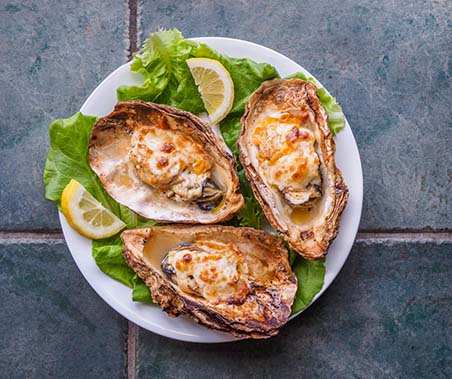Oysters and Vibriosis
What You Need to Know
- Eating raw or undercooked oysters that contain Vibrio bacteria can make you ill.
- Some kinds of Vibrio bacteria cause the illness vibriosis.
- An oyster that contains Vibrio doesn’t look, smell, or taste different from any other oyster.
- Cooking oysters properly can kill Vibrio and other harmful germs they might contain.

Many people enjoy eating raw oysters. But eating raw or undercooked oysters and other shellfish puts you at risk for vibriosis and other foodborne illness.
What is vibriosis?
Vibriosis is an illness caused by some kinds of Vibrio bacteria. Vibrio naturally live in coastal waters where oysters live. Because oysters feed by filtering water, Vibrio and other harmful germs can concentrate in their tissues. When someone eats raw or undercooked oysters, germs that might be in the oyster can cause illness.
CDC estimates that about 80,000 people get vibriosis—and 100 people die from it—in the United States every year. Most of these illnesses happen from May through October when water temperatures are warmer. However, you can get sick from eating raw or undercooked oysters during any month, and raw oysters from typically colder waters also can cause vibriosis.
An oyster that contains Vibrio doesn’t look, smell, or even taste different from any other oyster. You can kill Vibrio in oysters and other shellfish by cooking them properly.
What are the symptoms of vibriosis?
Most Vibrio infections from oysters result in mild illness, including diarrhea and vomiting. However, people with a Vibrio vulnificus infection can get very sick. As many as 1 in 5 people with a Vibrio vulnificus infection die. This is because Vibrio vulnificus infection can lead to bloodstream infections, severe skin blistering, and limb amputations.
If you develop symptoms of vibriosis, tell your medical provider if you recently ate or touched raw oysters or other raw shellfish or came into contact with salt water or brackish water. Brackish water is a mixture of salt water and fresh water. It is often found where rivers meet the ocean.
Who is more likely to get vibriosis?
Anyone can get vibriosis, but you may be more likely to get an infection or severe illness if you:
- Have liver disease, cancer, diabetes, HIV, or the blood disorder thalassemia
- Receive immune-suppressing therapy for the treatment of disease
- Take medicine to lower stomach acid levels
- Have had recent stomach surgery
- Are 65 years or older
How do people get vibriosis?
Most people become infected by eating raw or undercooked shellfish, particularly oysters. Some people become infected by:
- Getting brackish or salt water in a wound, such as when swimming, wading, or fishing.
- Cutting themselves on an item, such as a rock or pier, that has come into contact with brackish or salt water.
- Getting raw seafood juices or drippings in a wound.
How can I stay safe?
Follow these tips to reduce your chances of getting an infection when eating or touching shellfish and other seafood:
- Don’t eat raw or undercooked oysters or other shellfish. Fully cook them before eating, and only order fully cooked oysters at restaurants. Hot sauce and lemon juice don’t kill Vibrio bacteria and neither does alcohol.
- Some oysters are treated for safety after they are harvested. This treatment can reduce levels of Vibrio in oysters, but it does not remove all harmful germs.
- Separate cooked seafood from raw seafood and its juices to avoid cross contamination.
- Wash your hands with soap and water after handling raw seafood.
- Stay out of salt water and brackish water if you have a wound (including from a recent surgery, piercing, or tattoo).
- Cover any wounds if they could touch raw seafood or raw seafood juices, or if you might come into contact with brackish or salt water.
- Wash open wounds and cuts thoroughly with soap and water if they contacted salt water, brackish water, raw seafood, or raw seafood juices or drippings.
What are tips for cooking shellfish?
Before cooking, discard any shellfish with open shells.
For shellfish in the shell, either:
- Boil until the shells open and continue boiling another 3–5 minutes, or
- Add to a steamer when water is already steaming and cook for 4–9 minutes.
Only eat shellfish that open during cooking. Throw out any shellfish that do not open fully after cooking.
For shucked oysters, either:
- Boil for at least 3 minutes
- Fry in oil for at least 3 minutes at 375°F
- Broil 3 inches from heat for 3 minutes, or
- Bake at 450°F for 10 minutes
Source:
Page last reviewed: June 29, 2022
Content source: Centers for Disease Control and Prevention, National Center for Emerging and Zoonotic Infectious Diseases (NCEZID), Division of Foodborne, Waterborne, and Environmental Diseases (DFWED)
